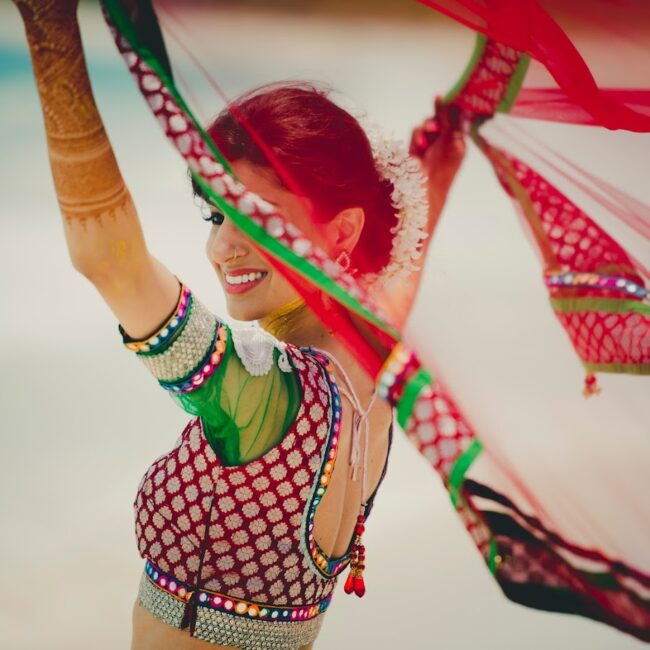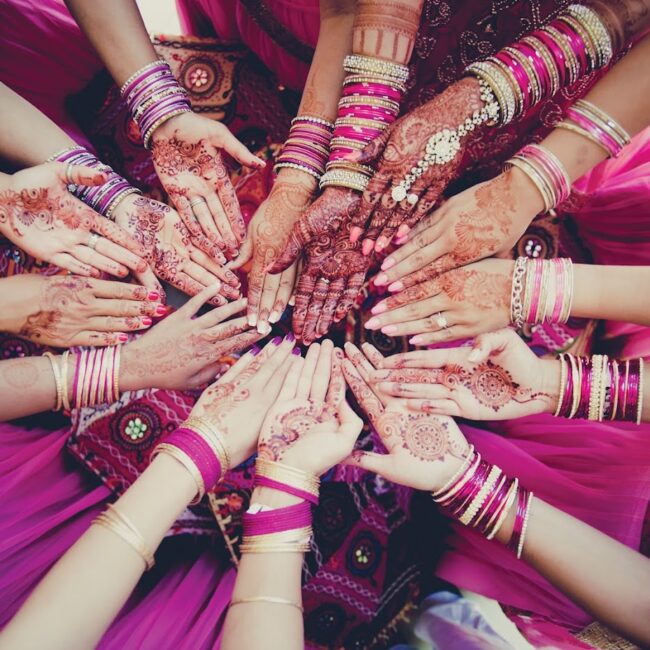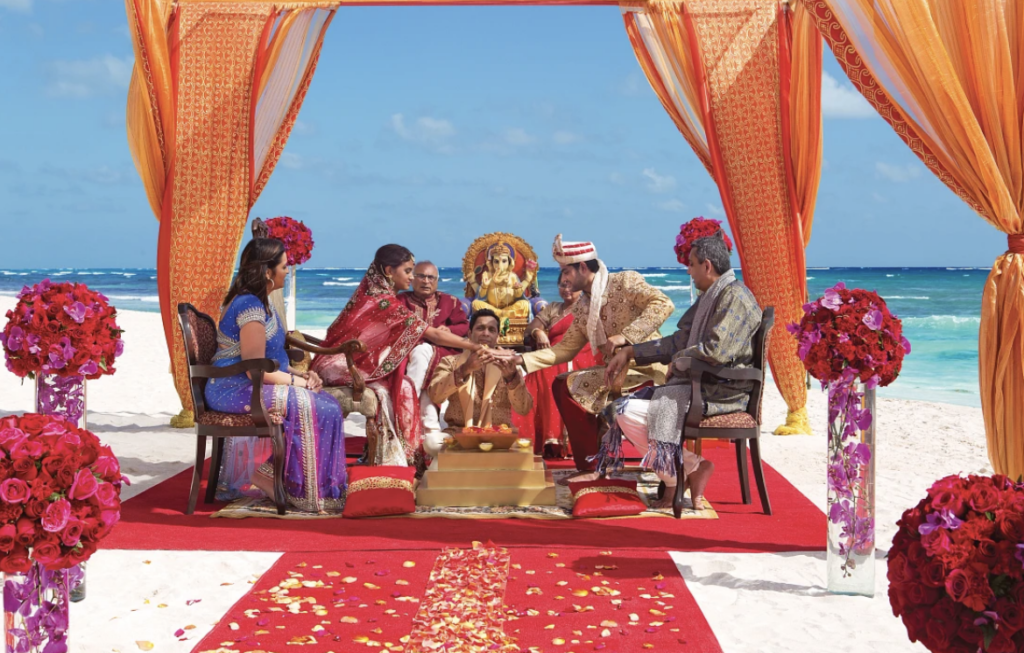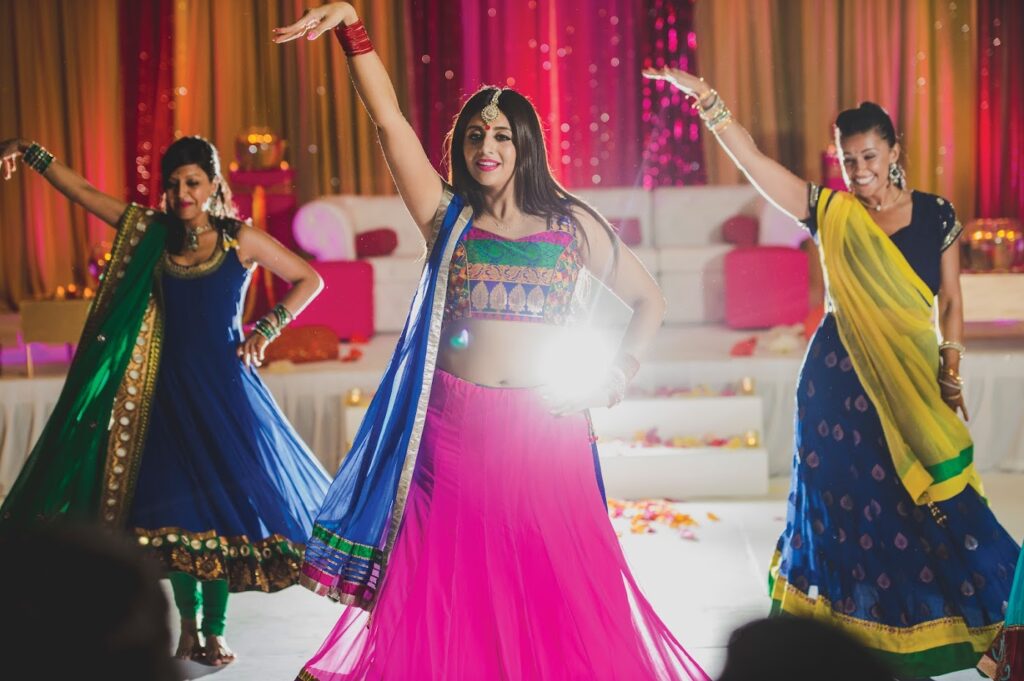Types of Indian Weddings





South Asian Religions and ceremonies that fall under South Asian Weddings
Hindu
Can come from any background or region of India- Hinduism is a religion, and Hindus are considered South Asian. They can be North Indian or South Indian, or anywhere in between, but if they follow Hinduism, they will be having a Hindu style ceremony (which varies culturally still by region).
Ismaili
Ismaili people come from an Islamic background as well. They follow the same religion of Islam as Pakistanis. However, being Ismaili means they come from a different sect of Islam, which creates some variance in their traditions for weddings. Ismaili people can come from any dispersed region throughout India and Western Asia (Pakistan). They have some variations in their Islamic religious practices, which is why a few of the traditions in weddings are different as well. The style of ceremony however is very much the same as the traditional Islamic wedding in that there is a contract signed for marriage. The cultural variations are the main difference, therefore there are some variations in the before and after ceremonies/events outside of the actual wedding that takes place.
Pakistani
Can come from any background in Pakistan or India. Pakistanis are regionally from Pakistan or West Asian countries next to India. The main way to know if they are Indian or Pakistani, is based off of their religious background- Pakistanis come from an Islamic background. Pakistan falls into the region of South Asia as well- the western countries have similar traditions of Islamic weddings, but can vary culturally within as well. The Muslim religion is typical with Pakistani people; although there are some different types of Muslims that fall into being “Pakistani”.
Sikh
Sikhism is a religion that people from Northern India (Punjab predominantly) follow. Punjabi cultural traditions are part of Sikh weddings. In a Sikh wedding, Punjabi cultural traditions and practices are followed for the events leading up to the wedding with events like the “Maiyya” or “Choora”. However, people identifying with a Punjabi cultural identity are not always Sikh by religion, they can be Hindu too. Therefore, many of the cultural events and traditions can be the same, but the ceremony itself is what sets apart a Sikh Punjabi and a Hindu Punjabi. If the couple identifies as Sikh Punjabi, they will have a Sikh-style ceremony with cultural Punjabi traditions before and after the wedding day; if the couple identifies religiously as Hindu, they will have a Hindu ceremony with Punjabi cultural traditions before and after the wedding day.
Christian
Sikhism is a religion that people from Northern India (Punjab predominantly) follow. Punjabi cultural traditions are part of Sikh weddings. In a Sikh wedding, Punjabi cultural traditions and practices are followed for the events leading up to the wedding with events like the “Maiyya” or “Choora”. However, people identifying with a Punjabi cultural identity are not always Sikh by religion, they can be Hindu too. Therefore, many of the cultural events and traditions can be the same, but the ceremony itself is what sets apart a Sikh Punjabi and a Hindu Punjabi. If the couple identifies as Sikh Punjabi, they will have a Sikh-style ceremony with cultural Punjabi traditions before and after the wedding day; if the couple identifies religiously as Hindu, they will have a Hindu ceremony with Punjabi cultural traditions before and after the wedding day.
PRE WEDDING

An event that is held on the first night of the wedding weekend to welcome everyone. Can be combined with other events (fusing Mehndi this evening to create a joint event). The feel of this event is usually very free-flowing, and a night for guests to come to the venue, check in, and mingle with others attending the event and get to know the families.
Mehndi
Mehndi or henna is a paste that is bought in a cone-shaped tube and is made into designs for men and women (usually mostly just women). Mehndi is derived from the Sanskrit word mendhikā. The use of mehndi is described in the earliest Hindu Vedic ritual books. It is a separate event during the wedding, as it’s traditional for the bride to fill her hands and feet with henna to be adorned for the ceremony. The Mehndi ceremony is done across faiths- Hinduism, Sikhism, and Islam all have this ritual as part of their wedding festivities. Family and friends also apply the designs to their hands in celebration. This event is very fun and festive, as it is the very beginning of the wedding events. After the henna is applied to the bride, she is to stay home until she is wed, as she is officially the bride! This event is mainly hosted for all of the women- bride, family, and friends alike apply henna to start the celebrations.
Sangeet
The term Sangeet is Sanskrit, which when translated into English literally means “as sung together”. The Sangeet ceremony takes place two or three days before the wedding. It’s held throughout most South Asian religions- Islamic, Hindu, and Sikh. There is song and dance associated with this event. The ambiance of this event is very lively, colorful, bright, and festive, filled with dance, music, and lots of energy. It’s usually the big party the day before the wedding takes place! With this being a dancing event, you will need to have a space where a large dance floor can be accommodated.
Mehndi
In Hindu and Sikh weddings, the Groom arrives at the marriage venue in a procession known as the Baraat. In Sikh Tradition, the Groom will wear a sahara and saafa while carrying a kirpan. They have a baraatis which is family members, groomsmen, and friends with him during his procession.
Garba
Garba is a form of dance, which was originated in the state of Gujarat in India. The name is derived from the Sanskrit term Garbha (“womb”) and Deep (“a small earthenware lamp”). It is an event held for Hindu weddings. Many traditional garbas are performed around a centrally lit lamp or a picture or statue of the Goddess Shakti. Garba happens during the time of “Navratri” in the Gujarati culture. This is also an event that takes place at Gujarati Hindu weddings in place of or in conjunction with the sangeet, as adding the element of garba can be simple by the music played and the style of dancing done. Because the event involves a lot of dancing, the event location needs to have enough space to accommodate a very large dance area where guests dance in a circle around a middle focal point, as this is the traditional form of garba.
Pithi / Haldi / Maiya / Vatna
This event comes once in life. It is a ceremony done across most South Asian religious backgrounds- Islamic, Hindu, and Sikh. Pithi is the paste that made out of chickpea flour, turmeric, rose water and other ingredients. Since ancient times, the Pithi ceremony is celebrated for both bride and groom separately. This entails rubbing a paste on the bride and groom’s face, hands and legs. Family members and friends often times have fun getting the bride and groom completely covered in the paste. This is a very fun event, as close family and friends are usually the only attendants for this, and get to personally be involved in the process. With it being a smaller ceremony, it usually is not considered to be a large event for weddings, as it can be done in a short period of time in the home or hotel room of the bride and groom.
Khoba Khobi
Khoba Khobi
These are the post nikkah games in an Islamic wedding. A woman of the family unties the cloth holding the bride and groom together and then they perform rituals such as the ponkhva (summon of the spirits of goodness to protect the couple) and the saapatia (where a clay plate is stepped on to release the items inside: lentils–symbolizing the bounty of nature, silver–a sign of material wealth, sugar– representing sweetness and harmony, and turmeric–a sign of good health). There is also a game of finding the coin in a bowl of water or rice (whoever finds the coin is considered the ruler of the house!). This is something that happens as the bride and groom come home after the wedding, so it is a small event with just family and close friends, which also makes it a very fun experience, as it’s a time for everyone to be involved in the fun! This is also a smaller ceremony, which is not usually considered as its own event for destination weddings. It’s more of an added part to the ceremony, and can be done anywhere that symbolizes as home for the couple, ie: the hotel room of the couple at their destination wedding location.
Grahshanti / Ganesh Puja / Saatak
A ritual/prayer in Gujarati Hindu weddings where Lord Ganesha is summoned to be present to remove all obstacles before the wedding and provide the newlyweds with happiness and prosperity for their married life to come. The same priest who conducts the wedding conducts this ritual, and it involves the Bride OR Groom and their parents. The bride and groom perform this separately in their own homes prior to the wedding ceremony. Without this prayer/ritual, the ceremony cannot take place. This is a religious event, therefore the ambiance of it is also filled with prayer and respect. This is also a smaller ceremony sometimes, and can be done at home or as a large event before the wedding. It’s very much up to the family preference on if they make this an event or keep it small as a ritual
Wedding Ceremony

Hindu
A religious Hindu ceremony has a “mandap”, or altar, where the bride and groom get married. A traditional mandap has 4 pillars, and seats the bride, groom, parents of the bride, and “Pandit”, or priest, as they perform the rituals in the ceremony in front of the “havan”, or sacred fire.. The ceremony lasts for about 1.5 hours and culminates with 7 circles around the fire to symbolize the vows being made for each other. There is a garland exchange as well as a necklace given to the bride as a symbol of marriage, called a “mangalsutra” and the husband will also put a “sindoor” on her forehead to signify that she is now a wedded woman.
The Baraat
One of the most exciting moment on the grooms wedding day, is the Baraat. The groom will arrive to his wedding venue on a white horse, a car, a decorated golf car ( on a resort), by boat, by helicopter or whichever way he chooses. For a Sikh Tradition, the Groom wears a sahara and saafa while carrying a kirpan. He has all his family members, groomsmen, and friends with him and this is known as a baraatis.
Sikh
A religious Sikh ceremony takes place in a Gurudwara (place where the Guru resides). This resting place is re-created and adorned beautifully for destination weddings, as the Gurudwara is a place of worship, and not usually found in many destination locations. The Gurudwara is created to hold the sacred Sikh scripture for the wedding ceremony. The bride and Groom sit in front of it while the Priest recites verses and performs the prayers. Similarly to a Hindu ceremony, the vows are taken in the form of steps around the Holy scripture in their presence. There is also a mangalsutra given to the bride in the Sikh ceremony as well to signify her as a wedded woman.
Christian
A traditional South Asian Christian ceremony happens at an altar, very synonymous to a non-South Asian Christian ceremony. The minor adjustments are made to the ceremony with cultural elements, such as the giving of the “manthrakodi” , or special gifted sari, to the bride that represents blessings after the marriage. There is also a “thali” that the groom puts on the bride, which is similar to the “mangalsutra”. It represents protection and marriage for the bride.
Islamic
A traditional Islamic religious ceremony called a “nikkah” happens within a closed location with a contract, a Priest (Imam), and witnesses. The Priest (Imam) will have the fathers of the Bride and Groom ask their children whether or not they approve of the marriage. If the Bride and Groom both answer yes, with witnesses present, the marriage is able to take place and the contract can be signed and the prayers can be said for their blessings. After this, the couple will do a ring exchange with prayers and vows recited to unite them as one.
Post Wedding

Vidaai
While a Hindu ceremony is joyous and celebratory, the ceremony ends with the “vidaigiri”, or farewell. This is the most emotional ceremony of the wedding, where the bride bids her final goodbyes to her family. During the vidaai ceremony the bride is is led to the doorstep of the home with her family at her side. Before crossing the doorstep, she throws back three handfuls of rice and coins over her head, into the house.. This symbolizes that the bride is repaying her parents for all that they have given her so far. Then she is given to the groom by the father to be taken away to her new home. This is done immediately after the exit from the mandap (altar), and is not considered a completely separate event for the wedding.
Rukhsati
This term translates to “sending off”. This term is used in Islamic weddings. It means the consummation of marriage. Now the spouses can be alone and have intimate relations. Rukhsati takes place after the Nikkah. The spouses may begin living together after this ritual as husband and wife. In most cases, this event takes place within a few hours after the Nikkah, but sometimes it can be postponed for a later time for social or personal reasons. This can be done as a large separate event after the ceremony in conjunction with the valima (reception). It’s up to the families if they would like to keep it more intimate or make it a large event.
Cocktail Hour
A Western tradition adopted as a pre-banquet event before the reception party.
Valima / Sitara
An event that is the second of the two traditional parts of an Islamic wedding. The Valima is performed after the nikkah, or marriage ceremony. The word Valima is derived from “awlam”, meaning to gather or assemble. It designates a feast in Arabic tradition, and is a type of Islamic reception event. The Rukhsati takes place after this celebration culminates. The valima is usually a larger event that guests, family and friends will attend as the reception.
Reception
The celebration of the wedding leads into this Western adopted tradition of having a party for the bride and groom in celebration of their union!


